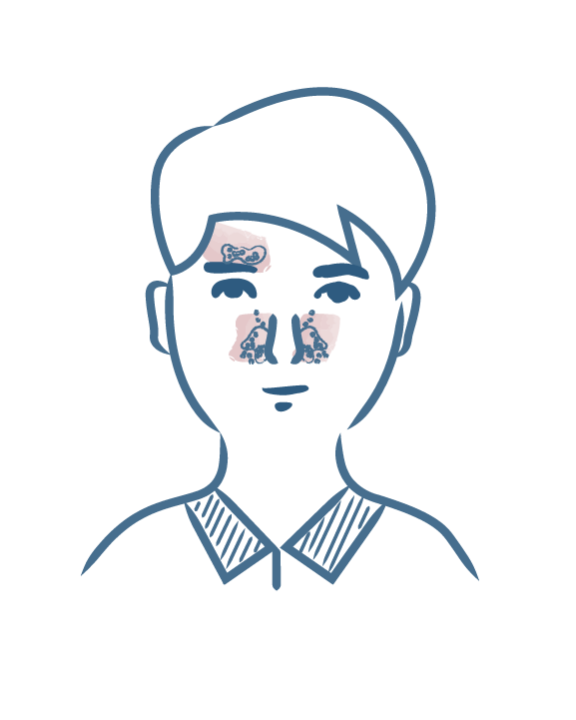
What is the best treatment for seborrheic dermatitis?
When your physician diagnoses seborrheic dermatitis, he or she will choose the most appropriate treatment based on the stage and location of the condition. There are a multitude of treatments available to healthcare professionals, including both medicinal treatments (which may require a medical prescription) and dermo-cosmetic products.
How should seborrheic dermatitis, a chronic condition, be treated?
There are three objectives in treating seborrheic dermatitis:
- Reduce the number of yeasts of the Malassezia genus present on the skin
- Fight inflammation
- Fight against excessive sebum secretion
All seborrheic dermatitis treatments are very effective in treating the symptoms, i.e. during flare-ups. However, to date, there is no treatment that can definitively cure seborrheic dermatitis. It is a chronic and recurrent condition, with relapses occurring almost systematically. Treatments must be therefore be used again and again, as often as necessary.
The chronic nature of seborrheic dermatitis means patients have to learn how to accept and live with it. Getting to know the disease, recognizing the symptoms, understanding and complying with the treatment recommended by your physician is not easy but is crucial for optimal treatment.
Several alternatives exist to treat seborrheic dermatitis. When a medicinal treatment is initiated, it is essential that a dermo-cosmetic product is provided alongside it to avoid possible early relapses.
These same dermo-cosmetic products may sometimes be sufficient on their own, depending on the severity of the condition and its location.
Several available treatments
There are various treatments for seborrheic dermatitis. Choice of treatment depends on the location of the symptoms and severity of the condition:
- Shampoos to treat for seborrheic dermatitis on the scalp,
- Creams to fight seborrheic dermatitis on the face.
- There are also sachet forms that are suitable for all locations: scalp, face and torso.
What are the best medications for seborrheic dermatitis?
There are several different families of medications:
Antifungals
Antifungals are usually prescribed as a first-line treatment. They are initially prescribed as an intensive treatment during the flare-up phase, then as a so-called maintenance treatment with reduced frequency of application to limit the risk of recurrence as far as possible.
They act locally by reducing the concentration of Malassezia yeasts in the lesions. There are two main types of antifungal agents:
- imidazoles (including ketoconazole)
- and pyridones (including ciclopirox olamine).
Selenium sulfide can also be used to treat seborrheic dermatitis on the scalp for its action on yeasts.
Topical corticosteroids
Topical corticosteroids are cortisone-based creams used for their anti-inflammatory effect on the skin. They are applied in a thin layer with a light massage to facilitate absorption.
They are often prescribed alongside an anti-fungal treatment. Over a short period of time, they help to soothe inflammation, redness and itching.
Gluconate
Lithium gluconate is also indicated in the treatment of seborrheic dermatitis on the face. It is prescribed for its anti-inflammatory action, and also acts on yeasts of the Malassezia genus.
The use of dermo-cosmetics as a complement to medications
In addition to medicinal treatments for seborrheic dermatitis, many dermo-cosmetic products are available in pharmacies. They can be recommended by your physician as a monotherapy but also as a complement or follow-up to a medical treatment.
There are various different types:
- Anti-fungal cosmetics: some products contain the same molecules as medications but in smaller quantities (lithium gluconate, selenium sulfide), while others contain new ingredients such as zinc, piroctone olamine or climbazole.
- Keratolytic agents to facilitate the removal of scales on the skin surface (tar, salicylic acid, geluamide, fruit acids, glycolic acid).
- Soothing active ingredients to reduce itching and soothe the skin.
A few tips to apply on a daily basis
As a complement to the medical or dermo-cosmetic treatment recommended by your physician and in order to optimize its efficacy and improve the condition of your skin, it is recommended to adopt a few simple hygiene practices on a daily basis.
It is advisable:
- To avoid scratching scales as this may cause skin inflammation,
- But also to follow and comply with the recommendations for the use of the products (such as duration, quantity and frequency of application).
Our care routines
Irritated skin with redness and scales

